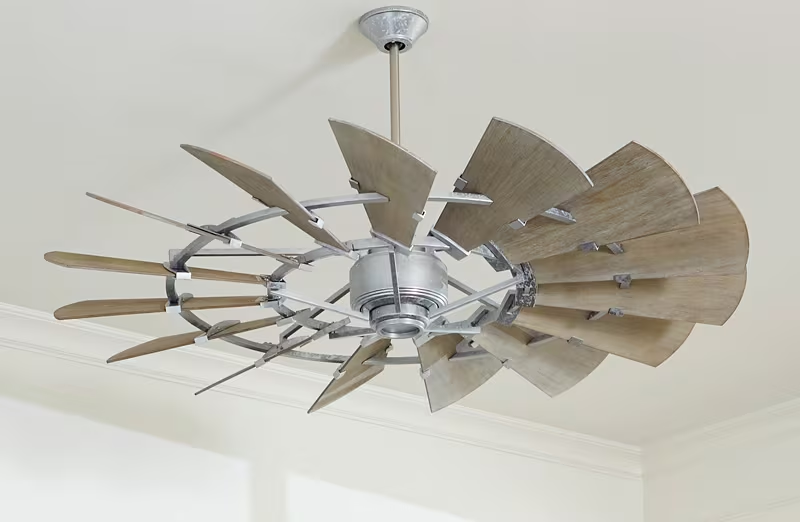Ceiling fans are more energy-efficient and stylish than ever, making them a must-have for many homes to help reduce energy costs and provide comfort. As popular and common as they may be, there are several myths and misconceptions surrounding ceiling fans. Knowing the reality of these myths can guide you and guide you in making more accurate decisions to benefit from a ceiling fan, as well as keep it always operating. In this post, we bust six common ceiling fan myths.
Myth 1: Ceiling Fans Cool the Air
One of the most common beliefs about ceiling fans is that they cool the room. Ceiling fans do nothing to reduce the temperature of a room. Instead, they blow air and your skin feels cooled by it because it provokes a breeze. The fan blades assist in evaporating sweat as they are circulating air and consequently leave you feeling fresher. However, if the fan is not turned on or there is no fan in the room, it does not change anything to the room temperature. That being said, you should probably turn off the fan when you go outside of the room.
Myth 2: Ceiling Fans Are Ineffective in Winter
A good number of people believe that ceiling fans can only be used during summer and are quite ineffective in winter. This myth arises from a few misunderstandings around the versatility of ceiling fans. It should be noted that most ceiling fans have a reverse from summer (blowing up) to winter (sucking down). In the winter this is helpful because warm air rises and when it does the fan pushes it back down to the floor level. By redistributing the warm air, this can then make a room feel warmer and save you money on heating costs.
Myth 3: Ceiling Fans Are Noisy
Another common myth is that ceiling fans are noisy and interruptive. Older or low-grade fans have the capability of being loud, but these days for most well-manufactured fans this is not a concern. High-quality fans are designed to run as silently as possible (e.g. aerodynamic fan blade design and efficient motors). But sometimes, if a ceiling fan is creating too much noise, apart from faulty installation or loose parts, it’s also because they require timely maintenance. By checking and tightening screws periodically, and installing them properly, you can reduce the noise.
Myth 4: Bigger Fans Are Always Better
Larger, equals better when it comes to ceiling fans is a common belief held by some people. A ceiling fan has a lot of factors that affect its performance; the room size and design of the fan are just some. For example, a fan that is too big for a small room could cause an overpowering breeze but a fan that is too small for a large space may not be able to move enough air. Make sure you choose a fan that is an appropriate size for the room and it will perform as you would want. The proper size of a fan is selectable from the manufacturer’s room dimensioning tables.
Myth 5: Ceiling Fans Can Replace Air Conditioning
Ceiling fans can certainly help improve comfort levels and save on energy costs, but they are not a substitute for air conditioning. Or go directly to the fan: Fans generate air movement that allows you to feel cooler, although what is happening is they are not even dropping the room temperature. In hot climates or during high temperatures, air conditioning remains the best solution to cool your indoor areas. Likewise, running a ceiling fan in tandem with your air conditioner can boost comfort and allow you to keep the thermostat set at a more energy-efficient level.
Myth 6: Ceiling Fans Are High Maintenance
One other negative point to some homeowners is the idea that ceiling fans need continuous work and attention, which can put many people off installation. Tasked with moving air within your home or outdoor space, you know that the last thing you want to do is maintain a fan. Ceiling fans are easy to maintain, cleaning dust off the blades and occasionally checking that all parts are tight usually keep this fan running. These days fans are long-lasting and built to be highly efficient, needing very low administration. Providing a ceiling fan is correctly installed, serviced as needed, and not altered can give you many years of dependability.
Dispelling the myths behind these well-known ceiling fan misbeliefs can help you better utilize and operate your fan. Ceiling fans make it feel as if a room is cooler, but the air that they blow across your skin is not lowering the temperature of the room. With proper use, they can work year-round, are fairly silent, and should be sized right for the space. Separating fact from fiction can greatly improve how well your ceiling fan works to lower your energy bills and keep your home cool.






